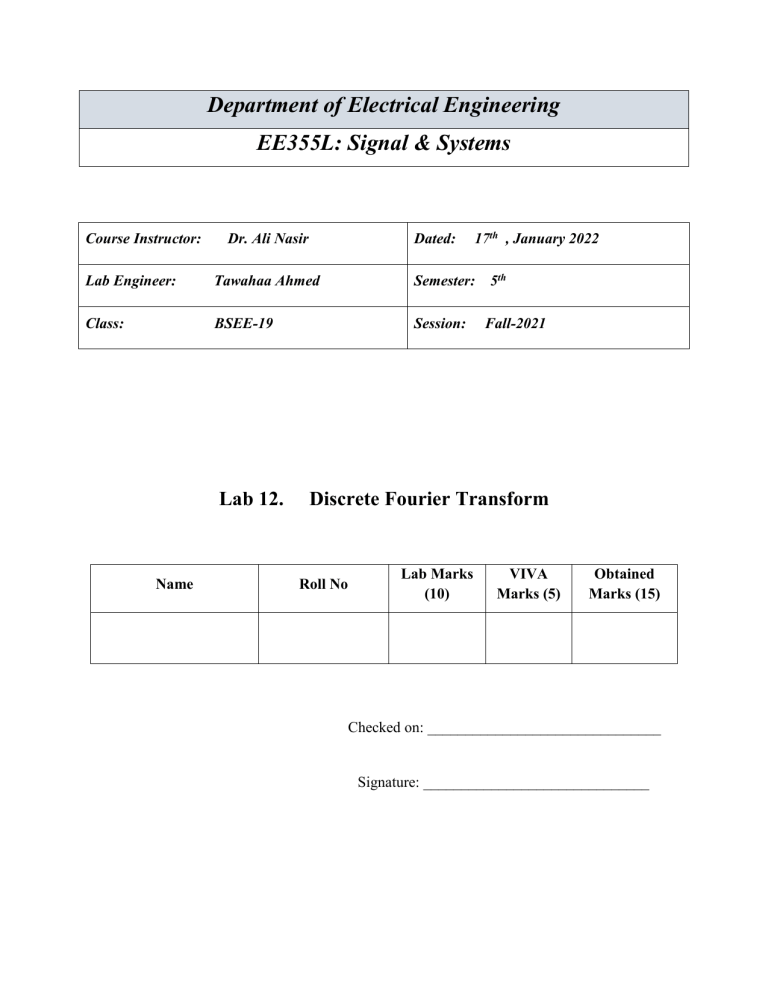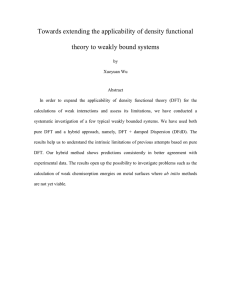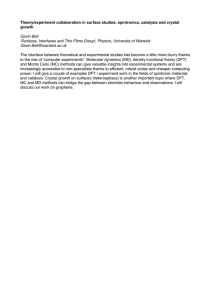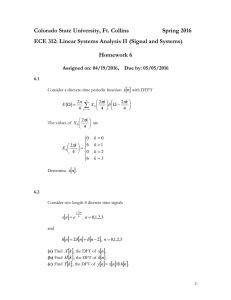
Department of Electrical Engineering EE355L: Signal & Systems Course Instructor: Dr. Ali Nasir Dated: 17th , January 2022 Lab Engineer: Tawahaa Ahmed Semester: 5th Class: BSEE-19 Session: Lab 12. Name Fall-2021 Discrete Fourier Transform Lab Marks (10) Roll No VIVA Marks (5) Obtained Marks (15) Checked on: _______________________________ Signature: ______________________________ 1 Introduction We’ve already suggested that there are many nearly-periodic signals that occur in the real world, with two notable examples being many musical signals and vowels in speech signals. These sort of signals can be analyzed using the Fourier Series or the DFT (applied to samples). We will use the DFT, principally because if we wanted to use the Fourier series, we would anyway approximately compute the Fourier coefficients with the DFT. In particular, let us consider a note played on a musical instrument like a flute or clarinet. Such a signal is nearly periodic with some fundamental period. If the note is played at “concert pitch,” for instance, it has a fundamental frequency of 440 Hz and a fundamental period of 1=440 seconds. Few musical signals, though, are purely sinusoidal. From our development of the Fourier series, we know that a periodic signal can be described as a sum of complex exponentials (or sinusoids) with harmonically-related frequencies. That is, the spectrum of our musical note is composed of a harmonic series. In particular, if the fundamental frequency is 440 Hz, higher harmonics will be at 880 Hz, 1320 Hz, 1760 Hz, and so on. Suppose that we have two instruments playing different notes (i.e., the two signals have different fundamental periods) at the same time. The signal coming from each instrument is a single harmonic series, but a listener “hears” a signal which is the sum of these two signals. By the linear combination properties of the Fourier Series and DFT, we know that the spectrum of the combined signal is simply the sum of the spectra of the separate signals. We can use this property to separate the two signals in the frequency-domain, even though they overlap in the time-domain. Suppose that we wish to simply remove one of the notes from the combined signal. We’ll assume that we have recorded and sampled the signal, so we’re working in discrete-time. We’ll also assume that the combined signal is also periodic10 with some (fairly long) fundamental period N0. If we take the N0-point DFT of a segment of the combined signal, we can identify the coefficients that make up each harmonic series. Then, we simply zero-out all of the coefficients corresponding to the harmonics of the note we wish to remove. When we resynthesize the signal with the inverse DFT, the resulting signal will contain only one of the two notes We can extend this procedure to more complicated signals, like melodies with many notes. In this case, we simply analyze and resynthesize each note individually. Of course, with more simultaneously-sounding notes and more 1 complicated music, this procedure becomes rather difficult. In this lab, we will implement this procedure to remove a “corrupting” note held throughout a simple, easily analyzed melody. Though somewhat idealized, the problem should help to motivate the use of the DFT and the frequency domain. 2 2.1 Lab Tasks Task 1 Marks[4] (Using the DFT to describe a signal as a sum of discrete-time sinusoids) In this problem, you will simply apply the DFT to a particular discrete-time signal, which is also contained in lab8 data.mat, namely, signal id. signal id is considered to be a periodic discrete-time signal with fundamental period No = 128 l̄ength(signal id). Take the No-point DFT of signal id. • Use stem to plot the magnitude of the DFT versus the DFT coefficient index, k. • Use the DFT to describe signal id as a sum of discretetime sinusoids. That is, for each sinusoid, give the amplitude, frequency (in radians per sample), and phase. 2.2 Task 2 Marks[6] (Use the DFT to remove undesired components from a signal) In this problem you will use the technique described in introduction to eliminate a noise signal from a desired signal. This signal, melody, is also contained in lab8 data.mat. This variable contains samples of a continuous-time signal sampled at rate fs = 8192 samples/second. It contains a simple melody with one note every 1/2 second. Unfortunately, this melody is corrupted by another “instrument” playing a constant note throughout. We would like to remove this second instrument from the signal, and we will use the DFT to do so. It is a good idea to begin by listening to melody using the soundsc command. 2 (a) (Examine DFT of first note) In order to remove the corrupting instrument, we need to determine where it lies in the frequency domain. Let’s begin by looking at just the first note (i.e the first 0.5 seconds or 4096 samples). This “note” consists of the sum of two notes — one is the first note of the melody, the other is the constant note from the corrupting instrument. Each of these notes has components forming a harmonic series. The fundamental frequencies of these harmonic series are different, which is the key to our being able to remove the corrupting note. Take the DFT of the first 0.5 seconds (4096 samples) of the signal. • Use stem to plot the magnitude of the DFT for the first note. • Identify the frequencies contained in each of the two harmonic series present in signal. What are the fundamental frequencies? (b) (Examine DFT of second note) By comparing the spectra of the first two notes, we can identify the corrupting instrument. Take the DFT of the second 0.5 seconds (samples 4097 through 8192). • Use stem to plot the magnitude of the DFT for the second 0.5 seconds. • What are the fundamental frequencies (in Hz) of the two harmonic series in this note? • We know that the melody changes from the first note to the second, but the corrupting instrument does not. Thus, by comparing the harmonic series found in this and the previous part, identify which fundamental frequency belongs to the melody and which to the corrupting instrument. (c) (Identify the DFT coefficients of the corrupting signal) In order to remove the “corrupting” instrument, we simply need to zero-out the coefficients corresponding to the harmonics of the note from the corrupting instrument. This is done directly on the DFT coefficients of each 0.5 seconds of the signal. Then, we resynthesize the signal from the modified DFT coefficients. • Based on this, and your results from the previous parts of this problem, which DFT coefficients need to be set to zero in order to remove the corrupting instrument from this signal? (Hint: Remember the conjugate pairs.) 3 (d) (Complete the function that removes the corrupting instrument) Finally, we’d like to remove the corrupting instrument from our melody. Download the file fix melody.m. This function contains the code that you’ll use to remove the corrupting instrument from the melody signal. For each note of the melody, the function takes the DFT, zeros out the appropriate coefficients (which you must provide), and resynthesizes the signal. • Complete the function by setting the variable zc equal to a vector containing the DFT coefficients that must be zeroed-out. • Execute the function using the command result = f ix melody(melody); 4





